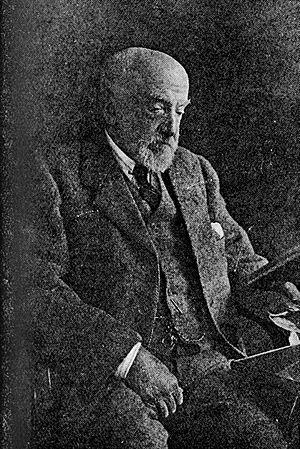Dukinfield Henry Scott facts for kids
Quick facts for kids
Dukinfield Henry Scott
|
|
|---|---|

D. H. Scott
|
|
| Born | 28 November 1854 |
| Died | 29 January 1934 (aged 79) |
| Nationality | British |
| Alma mater | Oxford University Würzburg University |
| Scientific career | |
| Fields | Botany |
| Institutions | University College, London Royal College of Science Royal Botanic Gardens, Kew |
| Doctoral advisor | Julius von Sachs |
| Author abbrev. (botany) | D.H.Scott |
Dr. Dukinfield Henry Scott (born November 28, 1854 – died January 29, 1934) was a British botanist. A botanist is a scientist who studies plants. He was a Fellow of the Royal Society and was known for his important research on plants, especially ancient plants called fossils. He also helped many young scientists, including women, learn about botany.
Contents
About Dukinfield Henry Scott
Early Life and Education
Dukinfield Henry Scott was born in London on November 28, 1854. He was the youngest of five sons. His father, Sir George Gilbert Scott, was a very famous architect.
Scott studied Natural Sciences at Oxford University. After that, he went to Würzburg University in Germany for his postgraduate studies. There, he learned from the well-known botanist Julius von Sachs and earned his doctorate degree.
Teaching and Research
In 1882, Scott became an Assistant Professor of Botany at University College, London. A few years later, in 1885, he became an Assistant Professor of Biology (Botany) at the Royal College of Science in South Kensington.
Scott was a pioneer in education. He was the first botany lecturer at University College who allowed women to attend his classes. This was a big step for women wanting to study science! One of his brightest students was Harold Wager, who later became a Fellow of the Royal Society of London.
In 1892, Scott was chosen to be the first Keeper of the Jodrell Laboratory at the Royal Botanic Gardens, Kew. This is a very famous place for plant research. He worked there for fourteen years, until 1906.
After leaving Kew, he moved with his family to Hampshire in 1906. He continued to do research and publish his findings from his home until he passed away.
Contributions to Science
Throughout his life, Scott wrote many books and scientific papers. He focused on botany (the study of plants) and palaeobotany (the study of ancient plants, often from fossils). He worked closely with other experts in palaeobotany, like William Crawford Williamson.
Besides his research, Scott also helped the wider scientific community. He served as General Secretary of the British Association from 1900 to 1903. He was also President of the Royal Microscopical Society and the Linnean Society.
Awards and Honours
Dukinfield Henry Scott received many awards for his work. He became a member of the Royal Swedish Academy of Sciences in 1916 and a Fellow of the Royal Society in 1894. In 1930, he was made an Honorary Fellow of the Royal Society of Edinburgh.
He was also given several important medals:
- The Royal Medal from the Royal Society in 1906.
- The Gold Medal from the Linnean Society in 1921.
- The Darwin Medal from the Royal Society in 1926.
- The Wollaston Medal from the Geological Society of London in 1928.
He also received honorary degrees from universities like Manchester and Aberdeen.
Family Life
In 1887, Dukinfield Henry Scott married Henderina Victoria Klaassen. She had been one of his first students. Henderina continued her own research after they were married. She also helped Scott by creating illustrations and indexes for his books. They had seven children together.
Selected Books
- Scott, Dukinfield Henry (1894, 1896). An Introduction to Structural Biology. (2 volumes).

